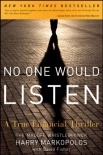No One Would Listen: A True Financial Thriller, Harry Markopolos [graded readers .TXT] 📗

- Author: Harry Markopolos
Book online «No One Would Listen: A True Financial Thriller, Harry Markopolos [graded readers .TXT] 📗». Author Harry Markopolos
One more time. Putting in all the work that would be required didn’t concern me, but the possibility—no, the probability—that the SEC would ignore us once again was really holding me back. The thought of gearing all the way up only to be shot all the way down was just too depressing for me.
It was in June that we got the very first hint that Madoff was in trouble. Frank was having lunch with a Benchmark Plus client, an Italian who ran an F3, a fund of funds of hedge funds. An F-cubed meant that investors were paying three levels of fees, but a lot of them believed it gave them increased stability. At some point during this lunch, Frank asked the same question that by now he’d asked five hundred times: “What do you know about Bernie?”
This time he got a very different answer. “Oh, Bernie,” the client said, waving his hands in disgust. “They’re saying in Europe that he’s been looking to take loans from banks.” He mentioned one bank that had actually refused to give him a credit line.
“That’s strange,” Frank responded. “Why would he need money? He’s got $30 billion from his clients. What does he need the banks for?”
The Italian had more news. “The banks have pulled him from their approved list.” He explained that two major international banks, the Royal Bank of Canada and Société Générale, were no longer lending money to their clients to invest with Madoff. “So he’s out looking for money.”
“I don’t get it,” Frank said, getting it. “I thought he was closed. Supposedly he isn’t taking any new money.”
“I don’t know,” the Italian said, clearly knowing. “But he’s getting aggressive. He needs money.” The Italian also mentioned that Bernie’s returns had decreased. When we had first looked at Broyhill’s numbers (discussed in Chapter 2), he was producing 19 percent net returns, but those had dropped steadily over the years.
“Who knows?”
Frank knew. And when he sent me an e-mail relating this conversation, I knew. Bernie was in trouble. He was having difficulty raising new money to feed the beast. The worldwide economy was slowing down, and he was beginning to feel it. I knew it was only a matter of time now before he collapsed completely. To me, that meant that like any cornered animal he was more dangerous than ever. He would do anything necessary to survive. So it made sense for me to do whatever I could to bring him down as quickly as possible—even if it meant going back to the SEC.
Finally, and reluctantly, I told Ed to set up a meeting with Garrity. It was scheduled for late October 2005. In preparation I began working on the submission that would accompany my presentation. I remembered that in August 2001 the Bush administration had successfully avoided paying any attention to an intelligence briefing entitled “Bin Laden Determined to Strike in U.S.” I hoped that the government had learned at least some lesson from that failure, so to make sure anyone reading my submission would know exactly what it contained, I titled it subtly “The World’s Largest Hedge Fund Is a Fraud.”
“The World’s Largest Hedge Fund Is a Fraud.” That was a pretty brash statement. I hoped it would make someone at the SEC besides Ed Manion pay attention.
For my protection, my name appeared nowhere in the report. So I had to establish my credentials. “I am the original source for the information presented herein . . .” my submission began. After outlining the way I gathered the information, I outlined my qualifications: “I am a derivatives expert and have traded or assisted in the trading of several billion $US in option strategies for hedge funds and institutional clients. I have experience managing split-strike conversion products both using index options and using individual stock options, both with and without index puts. Very few people in the world have the mathematical background needed to manage these types of products but I am one of them....”
And then I explained my fears. “As a result of this case, several careers on Wall Street and in Europe will be ruined. Therefore, I have not signed or put my name on this report. I request that my name not be released to anyone outside this SEC region without my express written permission. The fewer people who know who wrote this report the better. I am worried about the personal safety of myself and my family....”
And then over the next 15 pages, plus several attachments, I made my case. I described Madoff as “effectively the world’s largest hedge fund” but admitted no one knew how much money he was managing. I estimated it as somewhere between $20 billion to $50 billion, adding that “we don’t even know the size of the hedge fund industry so none of this should be surprising.” Then, I described 30 red flags, any one of which should have raised suspicion, but taken together they made it clear Madoff was a fraud. While I had no doubt it was a Ponzi scheme, Frank and Mike still were not entirely convinced he wasn’t front-running, so I did mention both possibilities, although I pointed out, “If BM was front-running, a highly profitable activity, then he wouldn’t need to borrow funds from investors at 12 percent implied interest. Therefore it is far more likely that BM is a Ponzi scheme.... The elaborateness of BM’s fund-raising, his need for secrecy, his high 12 percent average cost of funds, and reliance on a derivatives investment scheme that few investors (or regulators) would be capable of comprehending lead to a weight of the evidence conclusion that this is a Ponzi scheme.”
I went





Comments (0)